Austin Migration Insights
Sign up for the Central Texas Economy Report newsletter
Posted on 05/08/2023 by Chris Ramser
- Austin’s population grew by 61,349 in 2022, with 37,624 of that from domestic migration, 9,818 from international migration, and 13,907 from natural increase.
- Austin ranks first among the top 50 largest metros for new residents as a percent of total population.
- The greatest source of new migrants to the Austin metro is other parts of Texas, although the average annual number of new residents from elsewhere in Texas has decreased and the number from California, New York, and Washington has increased over the last five years.
- The most significant metro area net contributors to Austin MSA’s annual growth are Houston, Dallas, Los Angeles, San Francisco and San Jose.
According to recently released population estimates[1] produced by the U.S. Census Bureau, the Austin metro was the fastest growing of the top 50 U.S. metros from 2020 to 2022, adding 121,121 people or 5.3%. Raleigh ranked second with population growth of 4.7%. Dallas-Ft. Worth, San Antonio, and Houston were also in the top 10.

Included within the population estimates release were components of change which consists of statistics on domestic and international migration as well as natural population change (births and deaths). The following article will examine these estimates and migration insights from other Census Bureau data.
Population estimates & net migration
During the previous decade (2010-2020), the Austin MSA grew by about 56,350 people annually, according to the U.S. Census Bureau’s estimates.[2] Growth for the first two years of this decade outpaced the average annual growth of the 2010s with 2022 alone adding about 61,350 residents to the metro. Much of this growth in 2022 is attributed to net domestic migration, roughly 59.7%, with another 15.6% due to net international migration, and 22.1% from natural increase. Compared to last year’s growth, international migration is up from 6.2% in 2021, and up from 11.8% in the previous decade, while domestic migration is about at the level seen during the last decade, 59.8%, but down from last year at 75.2%.
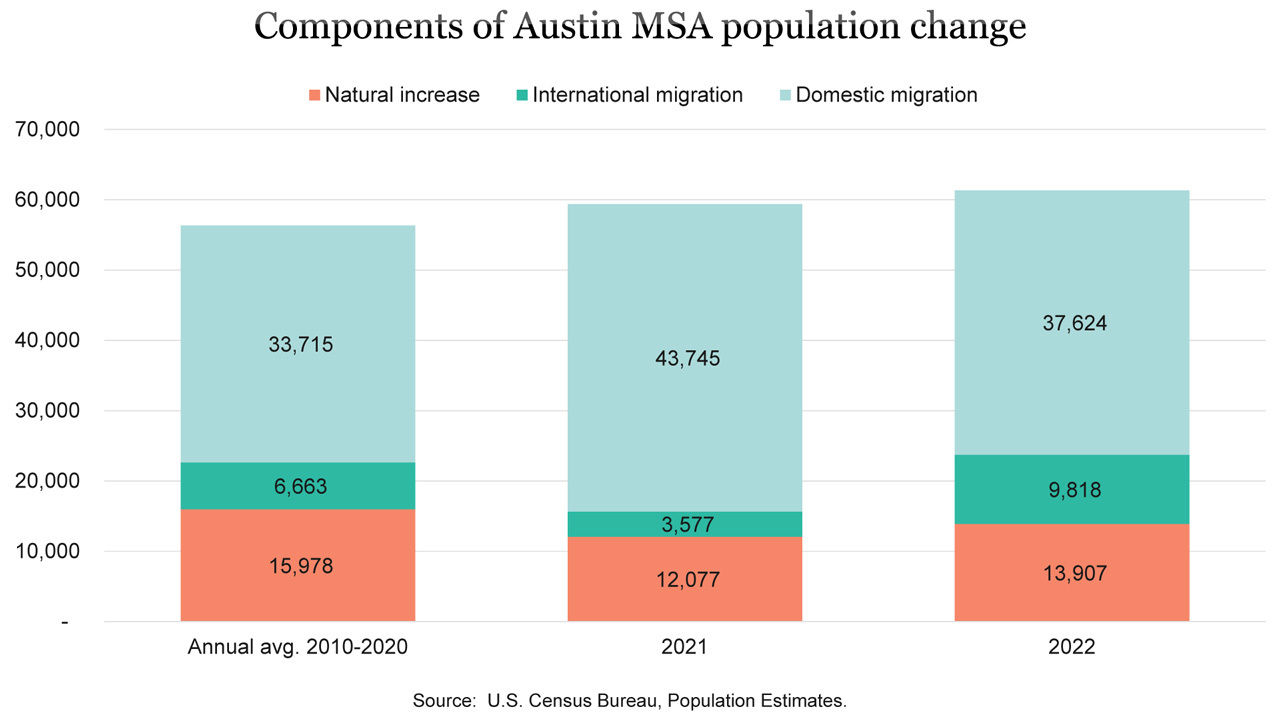
Austin ranks first among the top 50 largest metros for net new residents as a percent of total population. Between 2020 and 2022, Austin added 94,764 net new migrants, or 4.1% of our total 2020 population. Jacksonville and Raleigh came in second and third with 3.8% of their current population attributed to net migration. San Antonio and Dallas also made the top 10 with net migration since 2020 accounting for 2.8% and 2.7% of their metro’s total population, respectively. Houston was 13th with 1.8%. Across all U.S. metros, net migration since 2020 accounts for 1.3% of 2020 population.
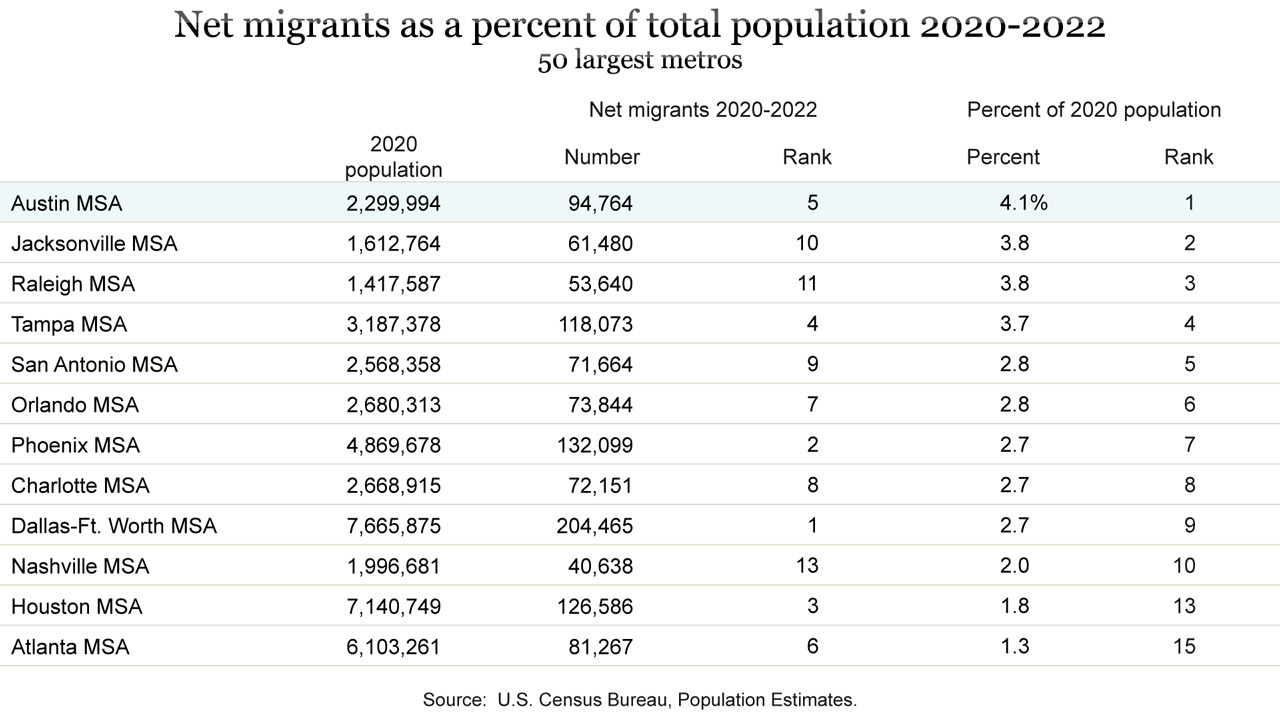
Half of the Top 50 largest metros had positive net migration from 2020-2022, while many of the largest metros saw drastic rates of negative domestic migration such as San Francisco, San Jose, New York, Los Angeles and Chicago. With last year’s release of the population estimates, the U.S. Census Bureau and the Brookings Institution chronicled the shift of population from these big cities during COVID and it appears the trend continued in 2022. Metros within the Sun Belt, especially Texas, Florida, Arizona, North Carolina, and Georgia gained population as a result of this migration.
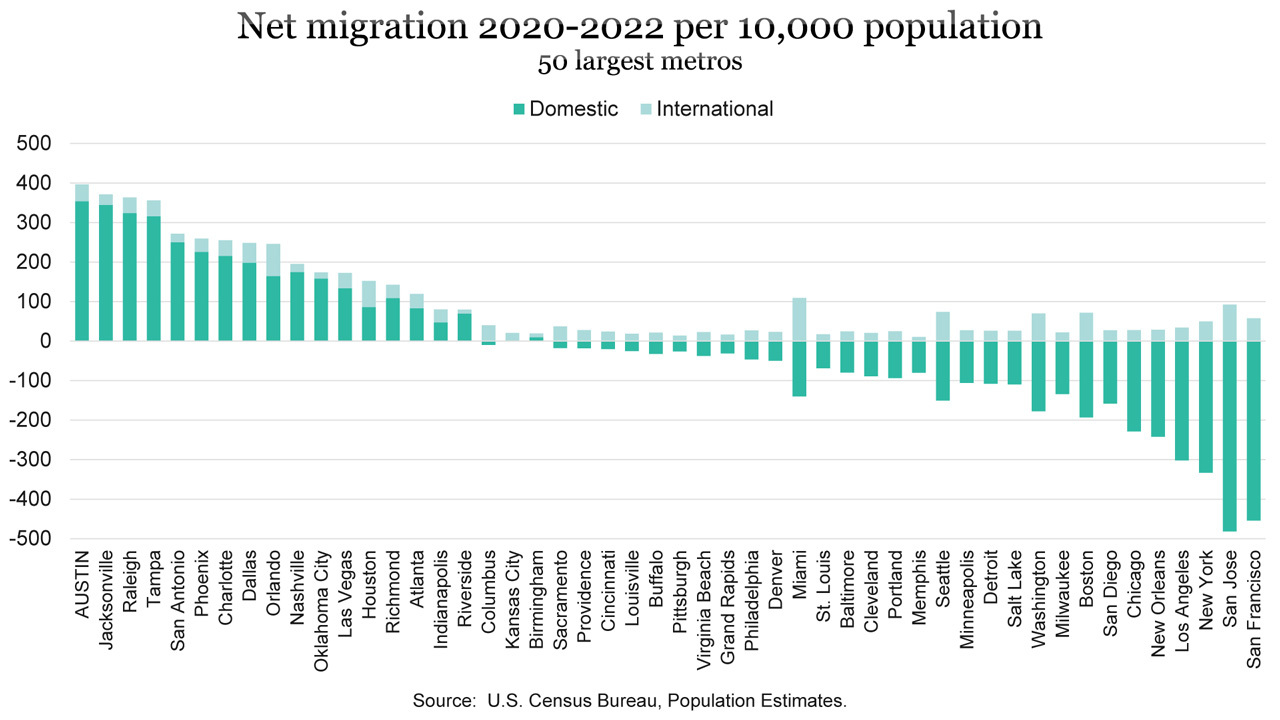
Overall growth in Texas in 2022 nearly mirrored Austin’s growth with net migration outpacing natural increase (births minus deaths) by three to one. Specifically, 74.7% of growth in Texas was the result of net migration compared to 77.3% in Austin, while natural increase was 25.3% of Texas’ growth and 22.7% of Austin’s. Albeit, the rate of births and deaths in Texas were both higher than Austin's.
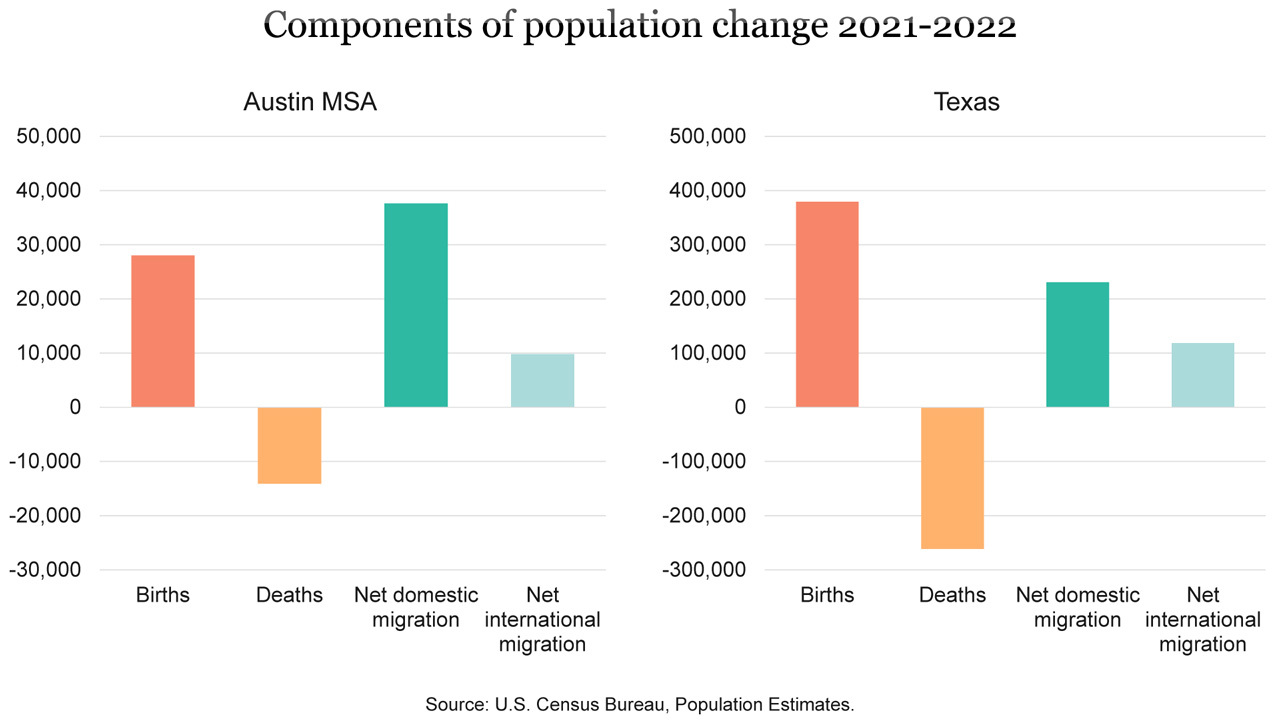
The region’s annual growth from 2021 to 2022, as calculated from the Census Bureau’s population estimates, was 62,985 or 173 persons per day. Of this daily number, net migration accounts for 130 new people and 38 are the result of births exceeding deaths.[3]
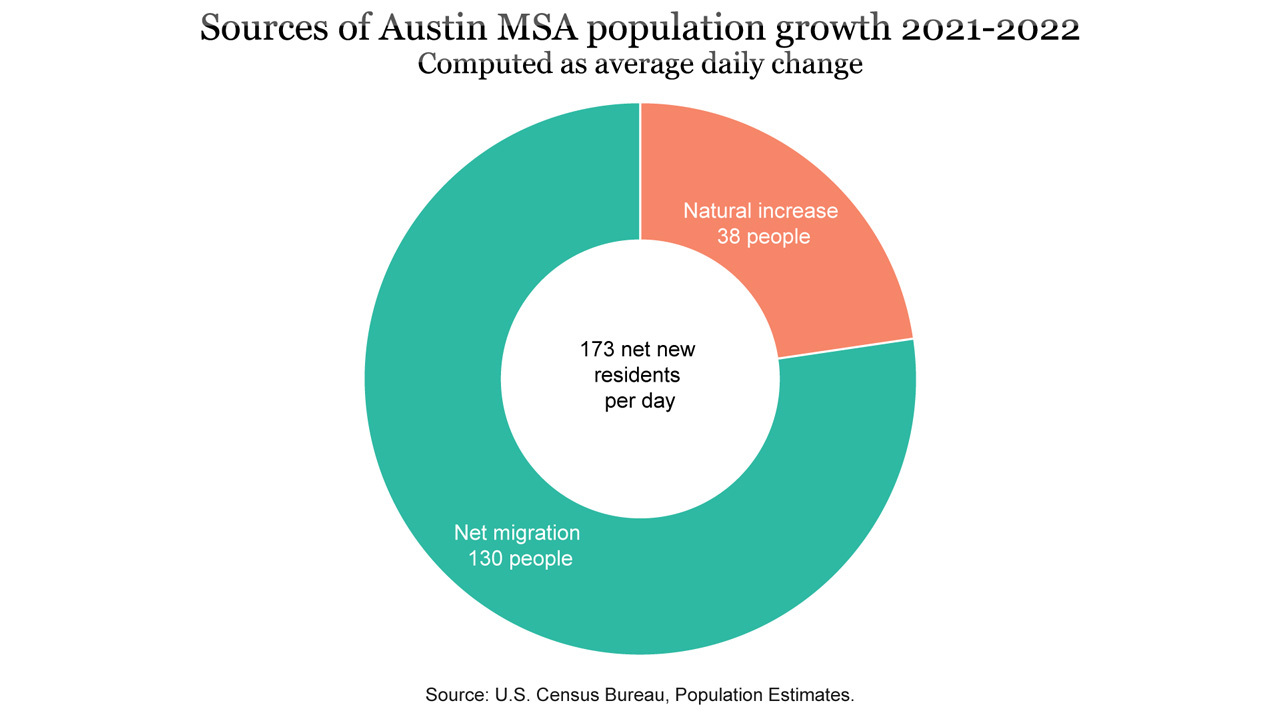
Geographic mobility
Additional insights into migration are provided by the Census Bureau’s American Community Survey (ACS). This annual sample survey, the replacement for the Decennial Census’s “long form” questionnaire, instituted following the 2000 Census, provides data on many demographic, economic, social, and housing characteristics of U.S. residents.
The ACS asks respondents questions about where they lived a year earlier. Of Austin’s 2,325,071 residents one year of age and older in 2021, 177,501 lived somewhere other than in the Austin MSA the year before. That’s 7.6% of Austin’s population and, among major metros, Austin ranks first for “movers in” as a percent of total population.
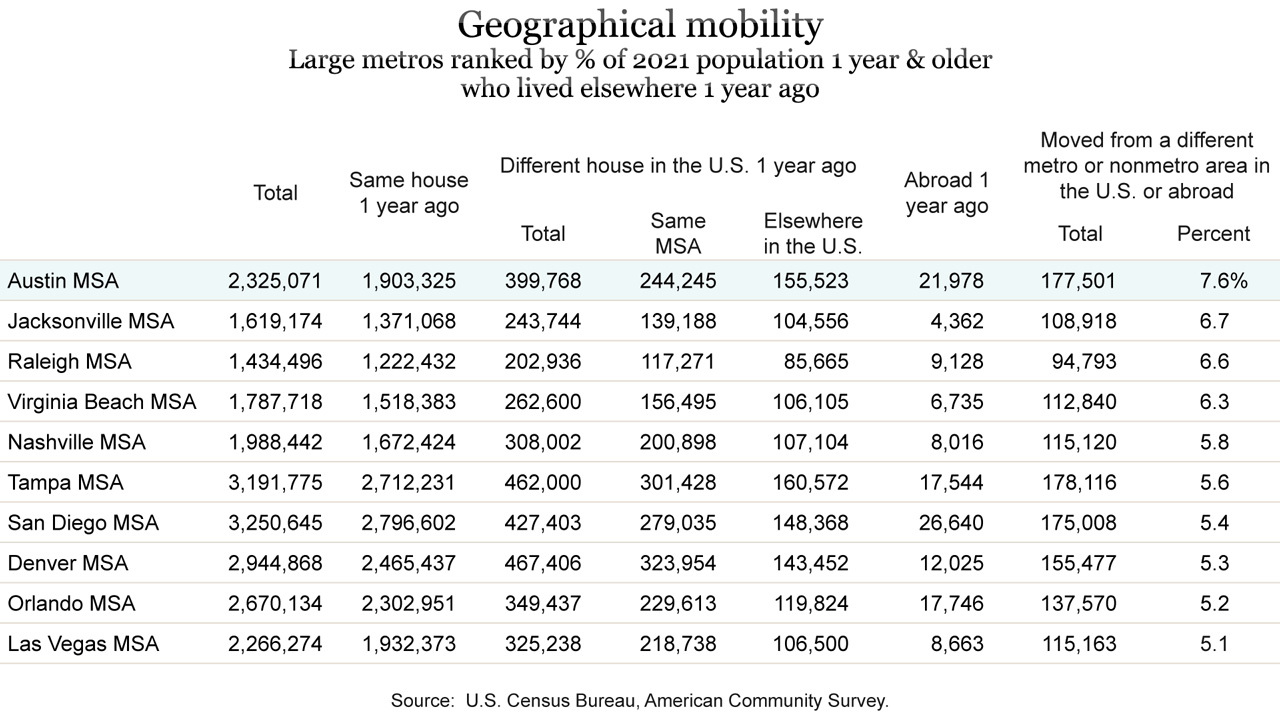
Origin of migrants
The ACS also provides detail on where people move from and move to. Using sample data collected each year, the Census Bureau aggregates five years of ACS data to generate estimates of annual migration between each U.S. county and publishes this data in its Census Flows Mapper application.[4] The current version of the map uses samples collected from 2016 to 2020 and estimates represent the annual number of movers during this period.
Data downloaded from Census Flows Mapper shows inbound and outbound flows, as well as net migrants, from a selected county to all other counties in the U.S. and Puerto Rico. Using the metro area aggregated tables, the Austin region received 128,374 domestic inbound migrants,[5] and sent 97,226 outbound migrants to other places, resulting in net migration of 31,148. Inbound flow was dominated by people arriving from other counties in Texas (50.3%), followed by California (11.4%), New York (3.1%), Florida (2.5%), and Washington (2.4%). Each state that contributed at least 1.0% of inbound migrants to Austin MSA are labeled in the pie chart below. All other states contributed 13.6% of the inbound total.
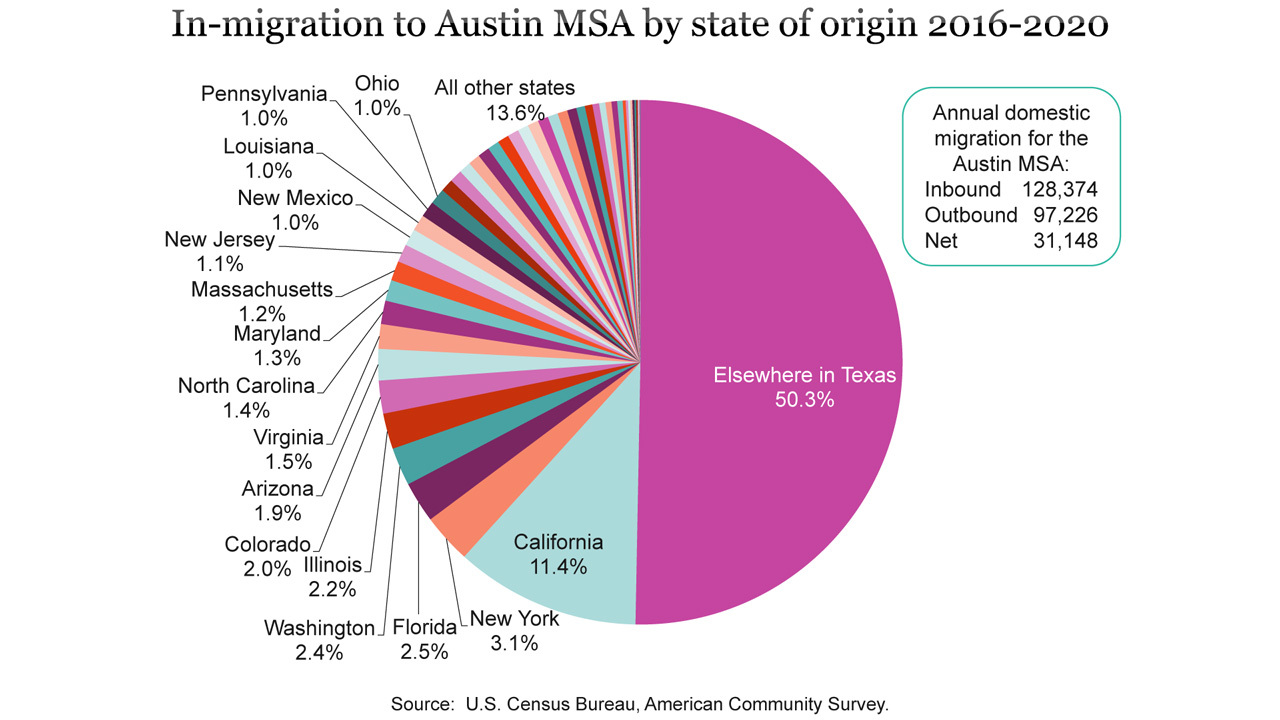
In-migration to the Austin region exceeded out-migration for 34 states, while Austin saw slight deficit flows with 17 states and the District of Columbia—that is, more Austinites departing to than coming from these states. Four states, excluding Texas with 10,305,[6] contributed over 1,000 net migrants each year to Austin, including California (9,802), New York (2,073), Washington (1,184), and Illinois (1,161) with another eight states contributing over 500 net migrants a year (Maryland, 779; New Jersey, 756; Hawaii, 676; Massachusetts, 663; New Mexico, 657; Ohio, 653; Nebraska, 639; and North Carolina, 634). The states that gained the most residents from Austin were Florida (-602), Georgia (-492), Oklahoma (-428), South Carolina (-380), and Idaho (-367). Since the information for this release is collected through a sample survey, it is possible that some of the states with smaller net migration totals could be within the margin of error for these estimates, meaning it is impossible to tell if the state’s net migration was actually a deficit or positive flow.
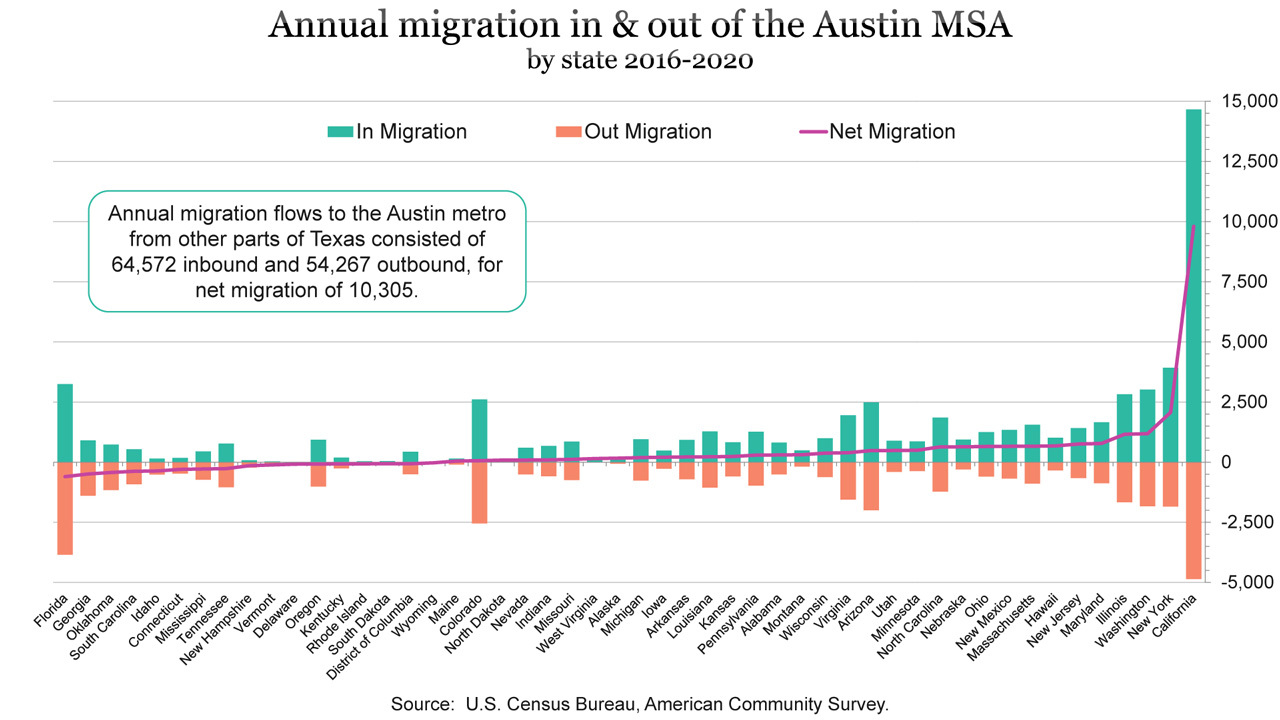
Net migration to the Austin region, while generally robust, has varied somewhat through the years depending on the economic conditions throughout the country. The two prior five-year periods (2006-2010 and 2011-2015) both saw roughly the same level of net domestic migration around 35,000 which was a greater level than the current five-year period 2016-2020 at 31,148. But net domestic migration to Austin was largely dominated by other parts of Texas with net migration at 16,300 in 2006-2010 and 16,969 in 2011-2015, but falling to 10,305 in 2016-2020. Now net migration from California at 9,802 in 2016-2020 has almost reached the level seen from elsewhere Texas. Net migration from other states such as New York, Washington, Maryland, Hawaii, and Massachusetts has also increased in the period 2016-2020 compared to the prior two five-year periods.
Just as migration to Austin has picked up in some places, it has decreased dramatically in others. Florida was previously ranked as one of the top five net migrant contributors to Austin in both 2011-2015 (over 2,800) and 2006-2010 (1,600), but is now the largest deficit flow in 2016-2020 at over -600. Flow from Michigan, Louisiana, Virginia, Arizona were once top 10 positive flows in 2011-2015 or 2006-2010 but are no longer in the top 10 for 2016-2020.

In addition to examining flows into/out of the Austin metro by state, we’ve analyzed the migration flows between Austin and other metropolitan areas and produced two tables of the 20 largest positive and deficit flows. Of the top 20 net flows to Austin, seven were from fellow metro areas in Texas and five were in California. Topping the list was Houston with a net 5,166 people to Austin each year over the past five years, followed by Dallas with 4,884, and Los Angeles with 3,318. The next three metros—San Francisco, San Jose, and New York—had similar levels of net migration to Austin including San Francisco (each at 2,100+). The two other California metros in the top 20 were Riverside and San Diego.
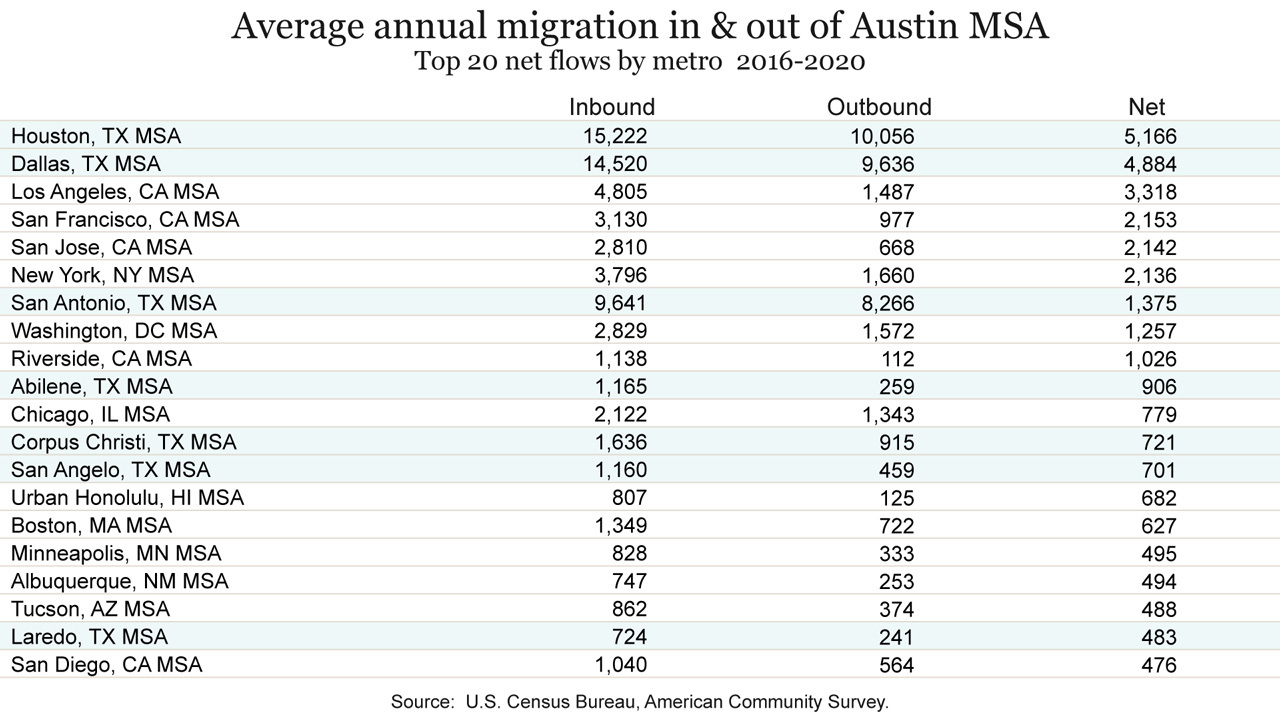
The top 20 metro areas with which Austin has a migration deficit included five Texas metros: Killeen, College Station, Lubbock, Waco, and Longview. Killeen was at the top of this list with an estimated annual inbound flow of 3,004 compared to outbound flow of 4,752 resulting in a net deficit of 1,748, while College Station’s net deficit was 842. Rounding out the top five were Lubbock at -771, Waco at -578, and Atlanta at -442.[7]
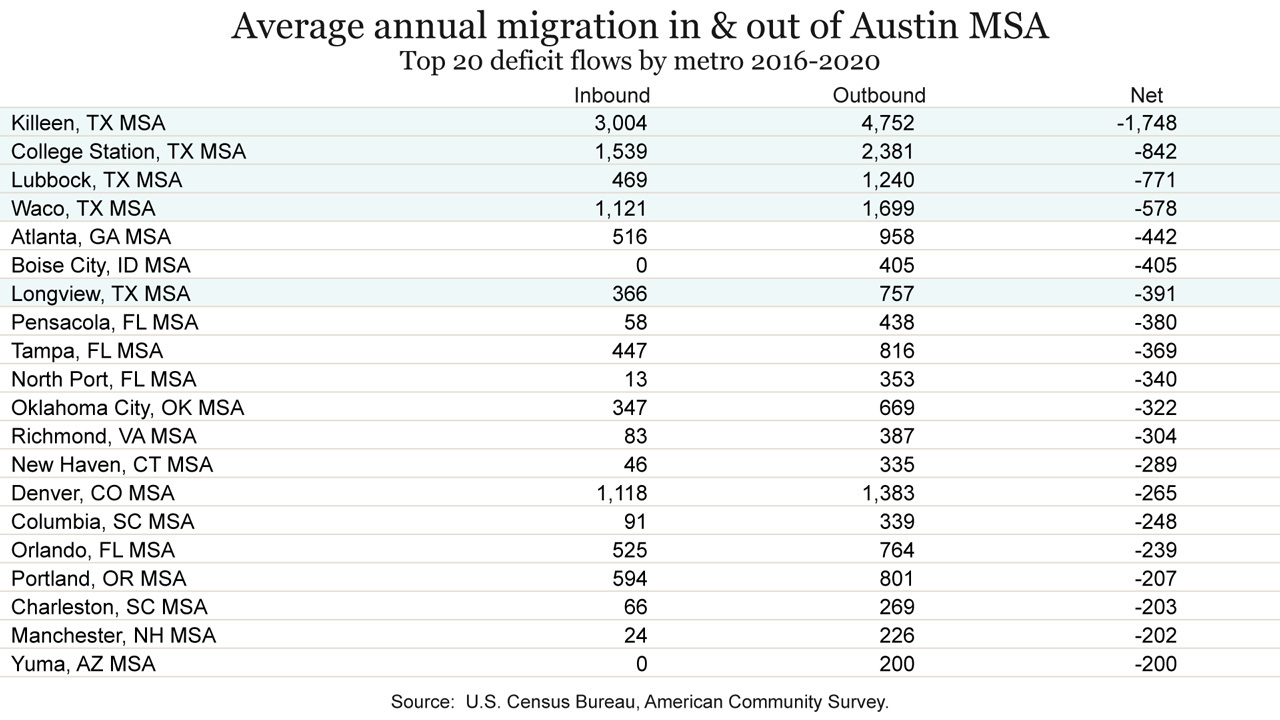
Other metros with a large volume of in and outbound migrants, but not among the top 20 net positive and deficit flows, were Seattle (1,673 inbound, 1,301 outbound), Phoenix (1,253 inbound, 1,306 outbound), El Paso (1,388 inbound, 964 outbound), McAllen (1,047 inbound, 933 outbound), Brownsville (777 inbound, 668 outbound), Philadelphia (631 inbound, 696 outbound), and Miami (685 inbound, 489 outbound). Below is a choropleth map of the net annual migration to Austin for all metros. Areas in purple indicate metros with a deficit flow for Austin while the darker greens are the biggest net migrant contributors.
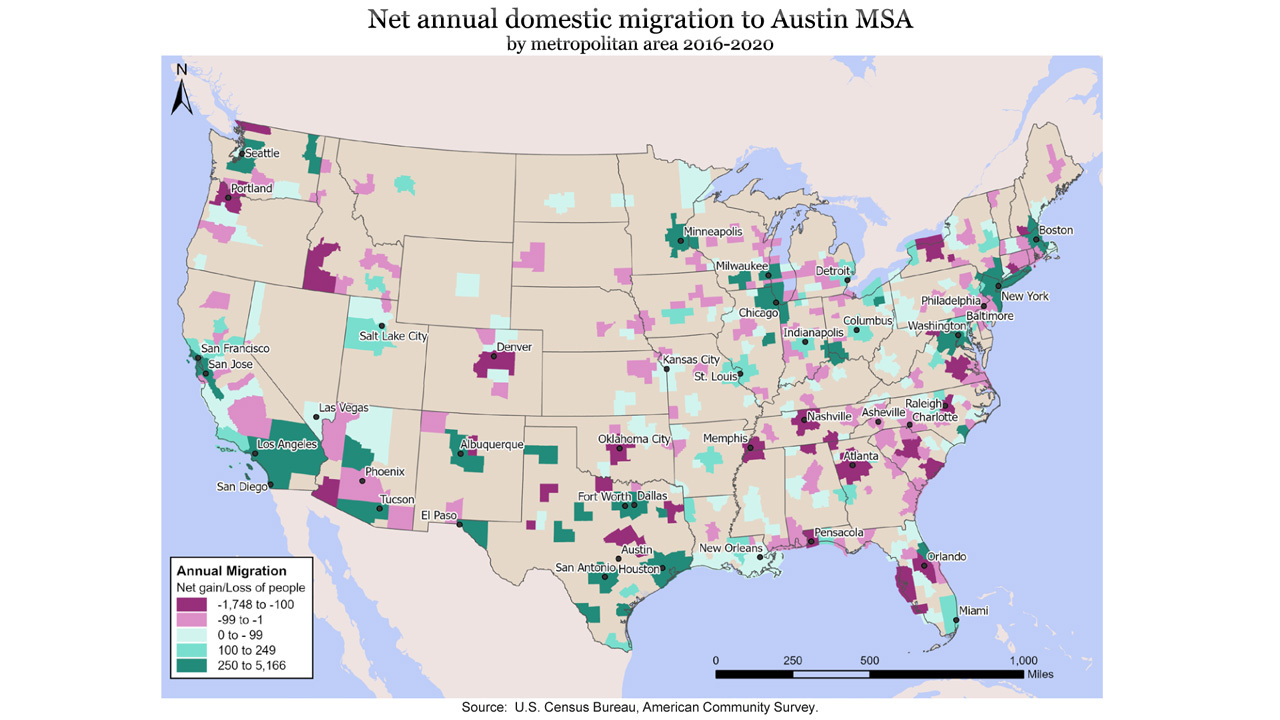
Analyzing migration between counties within the Austin area is also a possible use of this data. An annual estimate of 45,379 people moved from one county in the Austin metro to another. The below crosswalk table allows for looking up the total number of estimated movers from one metro county to another in the metro area. Start by picking a county from the vertical list of counties labeled “moved out of” and next pick a county from the horizontal list of “moved into” counties, finding the cell where the row and column intersection. For example, 16,454 moved out of Travis and into Williamson. Conversely, 10,828 moved out of Williamson and into Travis.

To download an Excel workbook of several worksheets of the data presented in this article, click here. The file includes a summary table of county, metro, and flows for the Austin MSA region as well as an individual worksheet of county-to-county flows for each of the five Austin MSA counties.
Additional migration data sources
The Internal Revenue Service (IRS) periodically publishes a dataset of U.S. migration data based on year-to-year address changes reported on individual income tax returns. The most recently available dataset is for 2020-21.
The Federal Reserve Bank of Dallas analyzed Texas metro migration trends in the five quarters just before the pandemic and the five quarters during the pandemic (2020Q1 to 2021 Q2) using high-frequency credit-bureau address changes in December 2021. The analysis found that migration to Texas sped up from already-high levels during the pandemic with 174,000 net new migrants moving to Texas in the five pandemic quarters compared to 109,000 in the five previous pre-pandemic quarters. The article found that much of the migration was from large coastal metros. Below is a portion of Chart 3 published within that article showing the top net origins for new Austin metro residents based on this address-change data.

The U.S. Postal Service (USPS) also publishes data files of number of requests received for change-of-address forms to and from each U.S. zip code. Available on their library page, the USPS has data for 2018 through 2023. Although this source doesn’t include information about the origin zip code, it does represent the scale of net migration for zip codes.
FOOTNOTES:
- The population estimates released in late March of each year typically consists of county and metropolitan statistical area (MSA) data. However, due to Connecticut’s switch from Counties to Regional Planning Areas as the building blocks for metropolitan areas, the release of the 2022 estimates for Metropolitan areas was delayed until May 18 and will not include the components of change. Because of this limitation, the Chamber has created a set of MSA population estimates and components of change using the county level data and the 2020 Metropolitan delineation files. Since data for Connecticut Regional Planning Areas was not available, the four Connecticut metros (Bridgeport, Hartford, New Haven and Norwich MSAs) were omitted from our analysis. Only one of these, Hartford MSA, is typically in the Top 50 largest metros. Hartford MSA grew by only 401 people and was not one of the fastest growing metros in 2021. ↩
- Population estimates are as of July 1st of each year, so for the period 2022, growth is from July 1, 2021 to July 1, 2022. ↩
- Population change also includes a residual component that is not attributable to demographic shifts. The residual component is the result of population controls applied to lower levels of geography or due to incorporation of accepted challenges and special censuses into the population estimates. Sometimes the residual component is sizable enough to be noticeable, resulting in the individual components of change not equaling the total population change. In this case, the residual component was quite large for the Austin MSA from 2021-2022 at 1,636.↩
- Metropolitan area flows are also downloadable in excel from this site. ↩
- These calculations exclude migration to/from Puerto Rico.↩
- The Texas total here represents the non-Austin-MSA portion of the State, labeled as “elsewhere Texas” in the graphs.↩
- Perhaps underscoring some of the limitations of the data as a result of sample size and potential margins of error is the possible, but curious, 0 inbound migration from Boise City, ID, while 405 people were estimated to have moved from Austin to that mid-sized metro of 750,000. When dealing with sample survey data like the ACS, it is not uncommon to have margins of error in the hundreds range, and upon further examination of the net migration for Austin and Boise, ID, the margin of error was 280, which essentially means the deficit may be anywhere between 125 and 685.↩